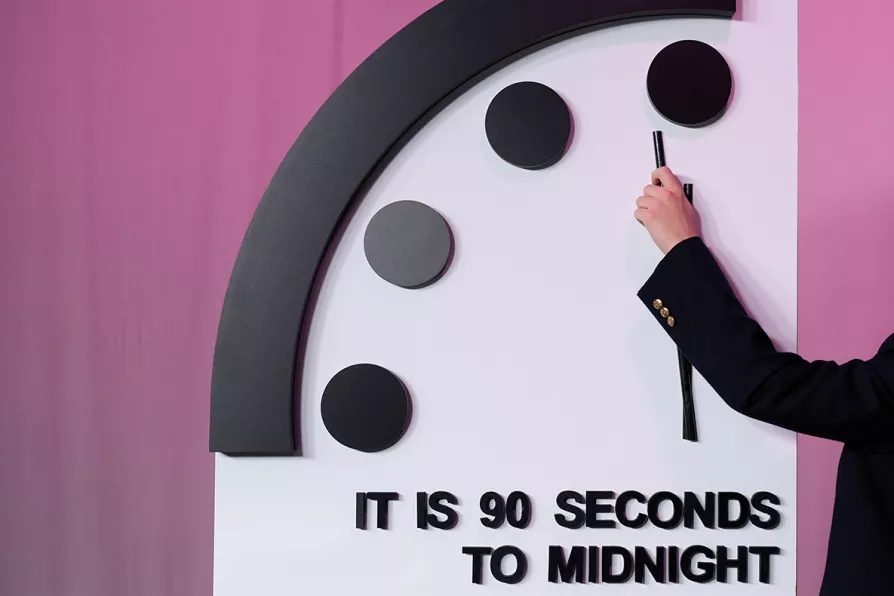Following a fratricidal period for the left with Morales and Arce at loggerheads, right-wing, anti-MAS candidates obtained over 85 per cent of the votes cast in the latest general election, writes FRANCISCO DOMINGUEZ

 The Bulletin of the Atomic Scientists announces the latest decision on the "Doomsday Clock" minute hand, January 23, 2024, at the National Press Club Broadcast Center, in Washington
The Bulletin of the Atomic Scientists announces the latest decision on the "Doomsday Clock" minute hand, January 23, 2024, at the National Press Club Broadcast Center, in Washington
RECENTLY, a US colleague in the nuclear disarmament movement wrote in an email: “I’m sorry to say that Marianne Williamson is unlikely to be elected president of the US, but if she were to be elected, she promised today that she would sign the TPNW.”
The UN Treaty on the Prohibition of Nuclear Weapons (TPNW), is a comprehensive nuclear ban that includes undertakings not to develop, test, produce, acquire, possess, stockpile, use or threaten to use nuclear weapons. It entered into force on January 22 2021. It has been ratified by 70 countries to date.
Williamson is a left Democrat making her second bid for the US presidency (she also ran in 2020). “Unlikely” was a considerable underestimate of her prospects. Williamson has as much chance of becoming US president as I do, and I’m not even running.
Signing the US onto the TPNW, as Williamson pledged, would mean a commitment to unilateral disarmament. In reality, the opposite is happening, and this was one of the chief concerns that influenced the position of the hands on the Doomsday Clock, which was reset on Tuesday.
The Doomsday Clock, established in 1947 by the Bulletin of the Atomic Scientists, assesses how close humanity stands to the brink of annihilation, largely due to the threat of nuclear war. It is set each year by the bulletin’s science and security board in consultation with its board of sponsors, which includes 11 Nobel laureates.
In 1947 the Clock was at seven minutes to midnight. By 1949 it was at three minutes. In 1991, as the cold war ended, it went back to 17 minutes to midnight. But in 2023, the hands moved ominously to 90 seconds to midnight, the closest we have ever come to doomsday.
On Tuesday, the Doomsday Clock remained unchanged, still at 90 seconds to midnight. But the risks assessed now include not only nuclear-armed Russia’s war in Ukraine, which largely prompted last year’s move forward but also nuclear-armed Israel’s war in Gaza and the risk this could escalate into a wider regional conflict involving other nuclear weapon states.
Also factored in are the dangers represented by the climate crisis and developments in biotechnology and Artificial Intelligence (AI).
Our continued peril, as represented by the clock, is largely driven by the failure of nuclear-armed countries to eliminate their arsenals, as required by the nuclear non-proliferation treaty, to which the major nuclear powers — the US, Russia and China — are signatories. (None of the nuclear weapons powers have signed the TPNW.) Instead, these countries are increasing or “modernising” their nuclear arsenals.
“Arms control has come to an end,” observed Alex Glaser, co-director of the Programme on Science and Global Security at Princeton University, during the 2024 Doomsday Clock announcement. He pointed out that Russia has suspended its participation in the New Strategic Arms Reduction Treaty (New START) and withdrawn its ratification of the Comprehensive Test Ban Treaty, which the US has never ratified.
China’s increased nuclear arsenal now stands at 500 weapons, Glaser said, while there is talk in Washington of increasing the US nuclear weapons arsenal “to match China and Russia combined.” This would set up an unprecedented three-way nuclear arms race.
What’s needed, Glaser added, is “a change in posture.” Nuclear weapons can be launched all too easily, on the say-so of the US president, for example. Who that is matters deeply, but regardless, said Glaser, “it is a very dangerous arrangement.” Launch on warning and first use need to end or we risk “blundering into a nuclear war given we can launch [nuclear weapons] so easily," Glaser said.
With 2023 the hottest year on record, including dramatically violent weather events, and the disruptive capacity posed by AI, the clock remained where it was. Any hope for moving the hands further away from armageddon, the bulletin experts said, meant the US, with its sweeping global influence, must take the lead on climate mitigation and nuclear disarmament, while assuming its rightful and considerable share of the responsibility for the dangers we continue to face.
Linda Pentz Gunter is the founder of the non-profit Beyond Nuclear — Beyondnuclearinternational.org.

Danni Perry’s flag display at the Royal Opera House sparked 182 performers to sign a solidarity letter that cancelled the Tel Aviv Tosca production, while Leonardo DiCaprio invests in Tel Aviv hotels, reports LINDA PENTZ GUNTER

For 80 years, survivors of the Hiroshima and Nagasaki atomic bombings have pleaded “never again,” for anyone. But are we listening, asks Linda Pentz Gunter

Starmer’s decision to recognise Palestine only as long as Israel continues to massacre its inhabitants has been met with outrage, writes LINDA PENTZ GUNTER

The crew of the Freedom Flotilla boat, Handala, warned Israel to obey international law but are now in captivity, reports LINDA PENTZ GUNTER













